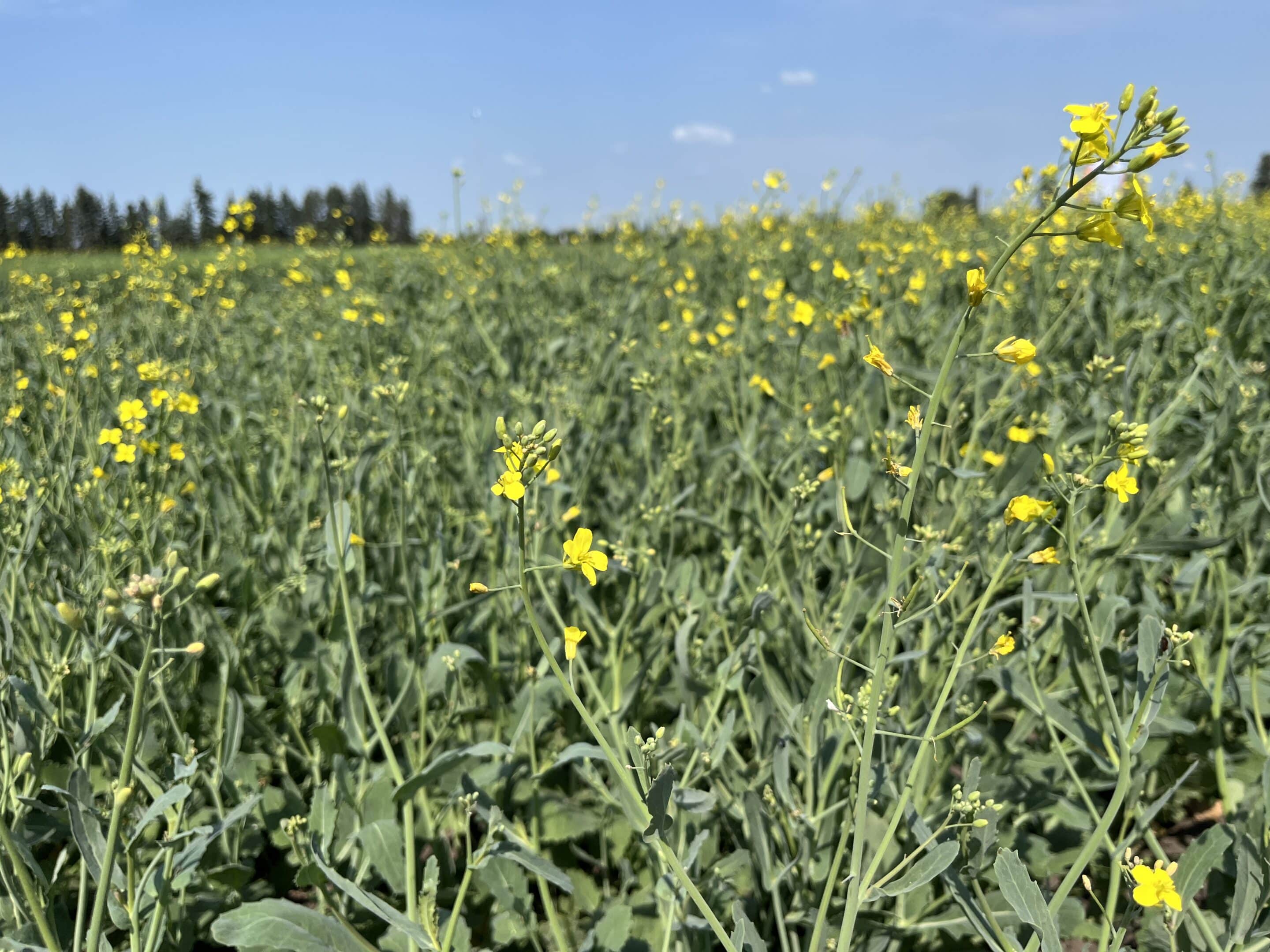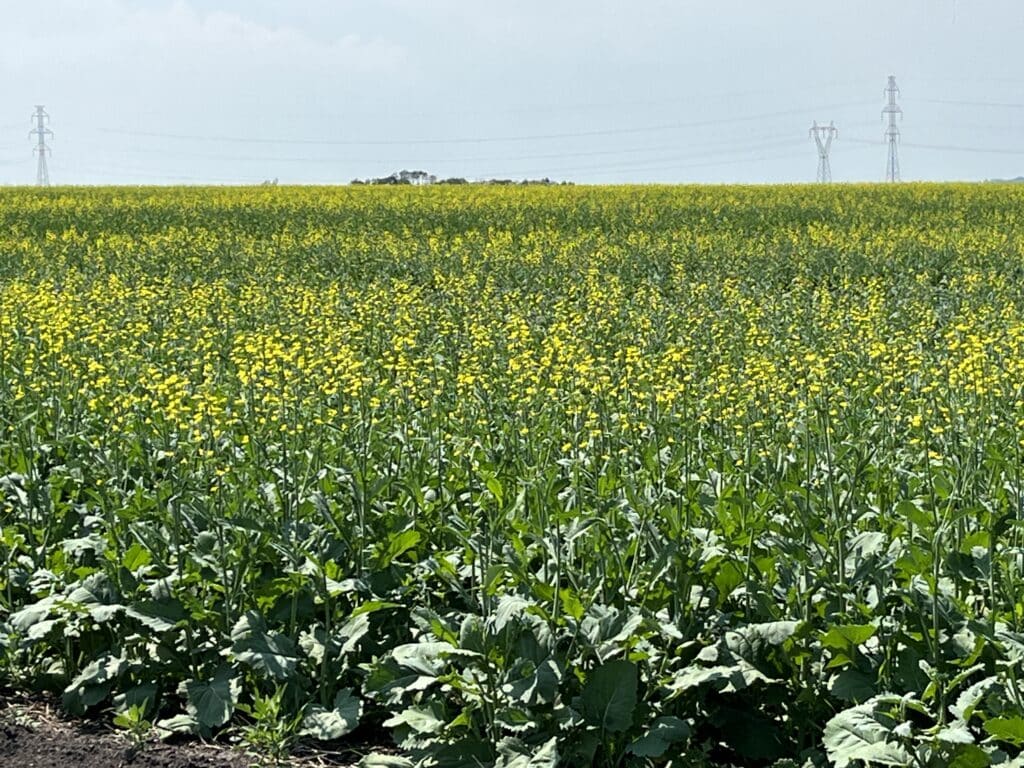Seeding canola wide can impact everything from seed cost to weed management to disease potential, but what spacing offers the best reward and least risk?
Typical row spacing in most commercial canola fields varies from seven to 12 inches. That’s higher than the six-to-eight-inch spacing used in canola’s earliest years, and much more precise thanks to today’s seeding technology.
Given new research findings and increasing agronomic understanding, is seven to 12 inches the very best option? Could a specific spacing inside that range offer maximum yield or quality benefit, or could going wider, say 15 inches or even 18, save seed while optimizing disease management?
Both wider and narrower row spacing deliver benefits most farmers are familiar with. Dragging fewer openers through the ground requires less horsepower and less fuel — an attractive upside. Extra inches between rows can make seeding smoother in wet, high-residue fields, it can also – alongside no-till or reduced-tillage – conserve moisture in dry fields. Narrower spacing allows the crop maximum access to resources including light, nutrients and moisture and supports mid-row fertilizer banding. Narrower rows can, under certain growth conditions, simplify management through more consistent crop staging when compared to the more branched plants in wider spacing.
The single biggest downside of wider row spacing is that the crop is less competitive against weeds, says Kelly Turkington, a crop pathologist at Agriculture and Agri-food Canada’s Lacombe Research and Development Centre. That’s a major concern, especially given increasing incidence of glyphosate resistant kochia and other herbicide resistant weeds.

Kelly Turkington, a crop pathologist at Agriculture and Agri-food Canada’s Lacombe Research and Development Centre
“As a consequence of a non-competitive crop canopy, your focus in terms of weed management is essentially almost solely based on the herbicide technology that you’re using. And the more reliance you have on herbicides, the more frequently you use them within and between growing seasons, the greater the risk for development of pesticide resistance,” he explains.
Impacts on Disease
One of the key reasons some might consider wider row spacing is the assumption that it should increase drying within the crop canopy’s micro-environment, thereby decreasing relative humidity and, consequently, the incidence of crop disease. Does that reality check out? Not necessarily, says Turkington.
“Speaking from a pathologist perspective, I really don’t see a huge benefit in changing the row spacings in that 12- to 15-inch range in terms of disease management. To see a dramatic effect on the canopy microenvironment and thus, potentially disease risk, you’d need to go well beyond 15 inches, probably in the order of a 36-inch row spacing. But in that situation, depending on the crop type you have, that’s when you’d start to have a very uncompetitive stand as far as weed management,” he says.
It’s also important to note the positive benefit of drying in the canopy is just one factor in disease’s complicated equation. In 1999 and 2000, Turkington and a team of colleagues conducted a study on how seed placement and row spacing in barley impacts disease, specifically net blotch. The team’s hypothesis was that wider-seeded rows should allow more air movement, thereby reducing canopy moisture and decreasing disease.
“In fact, [infection levels] were the exact opposite of what we expected,” he says. Rather than resulting in less disease, wider rows saw more disease. Why? Turkington says moving from a solid canopy with an 11-inch sweep opener at 12-inch row spacing to a an approximately one-inch knife opener at nine or 12-inch row spacing with distinct inter-row spaces didn’t seem to significantly impact the canopy’s relative humidity, the factor they’d assumed would increase disease. However, widening row spacing did likely result in increased air flow between plants, which allowed more wind-dispersal of the net blotch spores.
Whereas a solid canopy might slow spore dispersal of wind-dispersed diseases; it might conversely protect plants — at least somewhat — from rain splash-dispersed diseases like Septoria in wheat, scald in barley, and possibly secondary spread of blackleg in canola.
“You might hypothesize that with a solid canopy, the upper canopy leaves would help buffer and intercept those rain droplets, so you wouldn’t have splash dispersal to the same extent, but that’s just a hypothesis,” Turkington adds.
When it comes to sclerotinia — canola’s costliest disease — Turkington says manipulating row spacing, microclimates, air flow and other controllable factors are all minor compared to the disease’s single biggest risk factor: the amount of crop material above the soil surface. A heavy stand and high yielding crop, regardless of plant distribution, will be at most risk if weather conditions are conducive to disease.
Of course, disease is just one factor in crop production. The sweep treatment in Turkington’s study may have a negative impact on other pest issues, he says, as the increased amount of soil disturbance can activate weed seedbanks, leading to increased weed pressure from issues such as wild oats.
Opportunity to Decrease Seeding Rate?
Could it be possible to use wider row spacing to decrease seed costs? Maybe, but it’s a risky decision. The Canola Council of Canada reports that, due to canola’s ability to branch and fill space, canola at densities as low as four plants per square foot still has a high probability — as high as 90 per cent — of achieving similar yield to a higher density stand. That said, producers have just one opportunity to start well, and many factors can negatively impact emergence and plant stand development. As such, it’s always best to seed at recommended rates rather than trying to save a few dollars on seed at the front of the season.
Chris Holzapfel, research manager at the Indian Head Agricultural Research Foundation, ran a four-year row spacing and seeding rate field trial starting in 2013. The results from that study showed the varying treatments’ impact on overall yield was small and, in many cases, insignificant. That said, Holzapfel cautions producers against assuming fewer seeds per square foot, through wide row spacing and/or lower seeding rate, is safe.
“In our study, we did get away with some pretty low seeding rates in widely spaced rows without much impact on yield, but that’s a pretty dangerous game to play when you start dealing with the impacts of frost, flea beetles, variable distribution of plants and other factors. That could backfire pretty quickly. Sometimes you can get away with a shockingly low plant population with canola, but that’s never where you want to start,” he explains.
Starting in 2018, Steve Shirtliffe, a professor and field crop agronomy researcher at the University of Saskatchewan, ran a several year study, assessing canola row spacing of as low as six inches to as high as 30 inches at various seeding rates.
“Our main hypothesis was that we believed the more evenly you could get canola seeds spaced to each other — both between rows and within the row — the less seed you’d need. And we thought we might be able to compensate for row spacing with higher density,” he says.
Instead, what the study showed was a yield drop — small but evident — as row spacing exceeded 12 inches.
“As you go out wider and wider, you do start to see a decrease in yield. Initially it’s quite small but it gets bigger and bigger with more extreme row spacing,” he adds.
The ‘Solar Panel’ Effect
Shirtliffe says the finding makes sense if one thinks of a crop in its simplest functional terms.
“Your crop canopy essentially is a solar panel. The oils and carbohydrates and fibre all come from photosynthesis. The longer you can keep that solar panel healthy and functioning, the higher your yields can be.”
As such, the speed of canopy closure is directly correlated to final yield: the more hours of full crop cover; the more potential for that ‘solar panel’ to be productive. While it’s true that canola can compensate via branching for poor emergence or wide row spacing, delayed canopy close-up from any cause ultimately impacts yield.
“If you’re looking at 12-inch or 14-inch spacing, is that going to make a measurable difference? It’s not going to be huge. The canopy will still close in with maybe a one-day difference. But, as you get wider and that close-up takes longer, that’s going to make the difference,” he says.
“If you’re getting good ground cover quickly, you know you’re doing a good job. If you’re getting cabbaged canola without spacing, that’s the goal. If there are holes, however, and especially if they persist for several weeks, that’s where you’re losing yield.”
Ultimately, Holzapfel, Turkington and Shirtliffe all agree that the seven to 12-inch row spacing typical in most Canadian canola fields is optimal. While factors specific to an individual growing season might mean slightly wider spacing is ideal one year and slightly narrower spacing is ideal in another, the safest and most consistently beneficial spacing remains exactly what producers are already doing.
Header photo — A close up of flowering canola plants at a canola field located in central Alberta. Photo: Ashley Robinson
Related Articles
Marcus Samuel is Playing with Canola Genes
Western Canada Canola Performance Trials Ending
Better Seed Genetics Push Straight Cutting Canola Trend Forward






